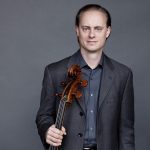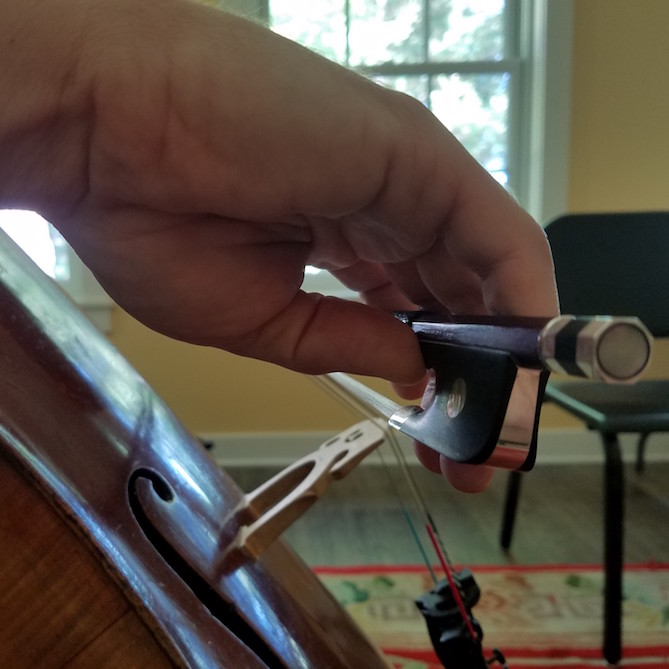Originally published on gregorybeaver.com.
For many of my student years as a cellist, I struggled to achieve a fully resonant sound on the cello. The ever-elusive goal would seem within grasp, and then I would start trying and tension would squelch the sound. Or I would finally achieve relaxation, and look down to see my bow gently dusting the edge of the fingerboard with rosin. Rarely was I able to fully engage the core of the string while releasing energy through my body.
As a teacher, I found producing a great sound to be a particularly interesting mission. I learned early on that telling students to play close to the bridge simply doesn’t work. If a student doesn’t naturally play close to the bridge, the bow will hover near the fingerboard for most of the music, only rarely taking a brief 2 second vacation to the bridge before wandering back north. Most students eventually learn how to do this, but the average time between starting and ability to play near the bridge as a basic sound tended to be around 6 months.
Recently, I discovered another method of teaching sound production that has been surprisingly effective, and is one that you can probably try effectively without my direct intervention. The secret is to harness an instrument you’ve been practicing far more often and with great success from a very early age: spoken language.
I have 2 daughters, the youngest just turned 2 years old. With both girls, it was fascinating to watch them try to learn how to vocalize the simplest sounds. It reminded me of watching beginning cellists learn how to convert sounds they hear into actions and create them on the instrument. Because we spend so much time learning how to convert sounds we hear or imagine into the physical acts that create those sounds, we have wired up a whole bunch of neurons that can be used to help teach us how to play cello better.
The key to harnessing this innate knowledge built up from years of practicing speaking is to understand how it connects to cello playing. Every sound we play on a stringed instrument contains the fundamental pitch and a whole host of overtones above that pitch. When you play far from the bridge, it removes the highest overtones, leaving just the fundamental pitch. This is a sound we perceive as “hollow.” The closer to the bridge you get, the more high overtones are present in the sound. Once the bow is close enough to the bridge that the bow speed is too fast to maintain the core of the sound, the fundamental begins to dissipate in strength, leaving high overtones and a very strident whistling sound that composers have used to great effect (see: The Witches Dance from Berlioz’s Symphonie Fantastique or the end of the Scherzo of Beethoven’s Op. 131 Quartet or the 3rd movement of Debussy’s cello sonata or… but I digress)
These different mixtures of overtones create tone color, which we perceive as complementing pitch but not changing it. In spoken languages, these tone colors are represented using vowels. We can map a few vowels to the tone colors a cello produces. For example, the tone color of sul tasto, playing hollow sounds over the fingerboard, can be mapped to an “O” or “Ooh” vowel as in “Ghost” or “Ooh look a ghost.” A basic middle-of-the-road tone color produced about halfway between the fingerboard and bridge maps to “Ah” as in “Ahhh that sounds good.” As you approach the bridge, the sound maps best to an “Ee” sound as in “Wheeee.”
To train yourself to easily control where your bow sits, you will need to do 3 things:
- Hear the vowel sounds
- Say or sing the vowel sounds with the pitch you plan to play
- Physically translate those sounds into body motions
I find it helpful to first practice saying vowels, and noticing how you need to change your mouth and tongue. Be sure to exaggerate. When you say “ee” make sure you put your teeth together and lift your lips towards your nose and chin so your teeth are exposed. For “ah” be sure your jaw is dropped fully and lips open wide. For “oh” and “ooh” use the same jaw drop as “ah” but bring your lips together. Point your lips out for “ooh.” Use plenty of diaphragm pressure, so you feel your lips shaking and your cheekbones vibrate while you are speaking or singing the vowels. If you half-try this part, the rest of the work will not pay off for you.
After you have really experienced these vowels, then it’s time to practice physical gestures. First, take a simple tune, one you can play in your sleep, not the one you just learned, something from Suzuki book 1, like Twinkle Twinkle Little Star, and then play it with the bow on the bridge. Notice what it feels like, how your bow arm elbow needs to be much more open to keep the bow on the bridge. Then play the same tune over the fingerboard, notice how you need to use more hair and bow speed to keep the sound from cracking. Finally, play over the middle of the string and notice how that feels.
Finally, it’s time to combine these elements. Say “Ooh” and play the cello until you hear “Ooh” come out. Focus only on the sound of the vowel, and the feeling of making that sound as you speak and then recreate both the feeling of speaking the vowel and hearing it as you play the cello. Do the same for “Ahh” and for “Ee”
In my experience, simply asking for more “Ee” will instantly result in close-to-the-bridge playing from any student, regardless of whether I have worked with them before.
Why does this matter? It turns out that in large spaces like concert halls, vowels like “Ah” “Ooh” and “Oh” don’t project very easily to the back of the hall, unless you are playing one of the great violins. I once heard Anne Sophie-Mutter perform Mozart Concerti with the Boston Symphony, and she was floating away over the fingerboard and practically covering the BSO, it was magnificent.
If you are an earthly mortal like me, then you will be better served by focusing on high overtones, our friend the “Ee” vowel. These sounds project to the back of the hall. If you are trying to project an intimate, delicate sound, practice playing intimately and delicately with an “Ee” vowel sound. This will cause your bow hand to travel towards the bridge without having to wrestle with the cognitive dissonance of playing intimately (brain thinks: quiet -> far from the bridge) and projecting that sound next to the bridge (brain thinks: next to bridge -> loud). Otherwise your brain is thinking “ok, right. You want me to play loud and quiet, close and far from the bridge. Riiiiiiight…” and that won’t work for anyone.
So remember, when you need to find that special sound, try vocalizing the vowel you want to use in that moment, and let that train your body how to create the sound, no analytical thinking necessary!
 From the beginning of his work as a performer, cellist Gregory Beaver has been fascinated with the process of growth. This fuels his performing, teaching, and writing with a passion from 17 years of performing internationally with the Chiara String Quartet. It permeates his published writings in Strad Magazine, a book on computer programming, his contributions to the open source programming world and even his personal recipe for guacamole. After the Chiara Quartet concludes its performing activities in 2018, Mr. Beaver will take this passion and devote it to expanding his teaching activities.
From the beginning of his work as a performer, cellist Gregory Beaver has been fascinated with the process of growth. This fuels his performing, teaching, and writing with a passion from 17 years of performing internationally with the Chiara String Quartet. It permeates his published writings in Strad Magazine, a book on computer programming, his contributions to the open source programming world and even his personal recipe for guacamole. After the Chiara Quartet concludes its performing activities in 2018, Mr. Beaver will take this passion and devote it to expanding his teaching activities.
Teaching traditionally invokes the image of a staid classroom, clear curriculum and strict rules to be followed. Mr. Beaver is not interested in just conforming to what has been tried in the past. His experience in the bumpy career path of a professional string quartet illustrated quite clearly that a holistic understanding of life, art, and business is more energizing. His students have been on the receiving end of experiments for many years to help them develop the precise skills needed to unlock their true potential, as humans and ambassadors for their music, and not just as cellists. He is the author of several cello etudes called the “Impossible Etudes” and myriad exercises to fine-tune the specific needs of each student.
His writing touches on issues relating to self-awareness, on practicing effectiveness, on connecting to others more effectively in chamber music as well as poetry and larger issues with society and politics. Mr. Beaver writes for his blog, https://gregorybeaver.com, as well as CelloBello, where he is a regular guest on “cello chats.”
Before his professional life in the Chiara Quartet, Mr. Beaver studied with Joel Krosnick at the Juilliard School, and Norman Fischer at Rice University. He had the opportunity to work with great conductors such as Claudio Abbado, Pierre Boulez, Seiji Ozawa, played principal cello of the Tanglewood Music Center Orchestra, and won first prize at the Corpus Christi International Competition. He began his cello studies under Char Sherman as a Suzuki student and studied in high school with renowned pedagogue Louis Potter, jr. Mr. Potter studied with Willem Willeke at Juilliard, graduating in 1935. Mr. Willeke had a long and fruitful relationship with Johannes Brahms, perhaps explaining why Mr. Beaver feels an affinity for Brahms. Gregory loves to experience the completeness of things, and has performed cycles of Solo Bach, Beethoven Cello/Piano Sonatas, as well as Brahms, Beethoven, and Bartok cycles with the Chiara Quartet. He lives with his wife, Hyeyung Yoon, 2 daughters and cat in Lincoln, Nebraska.






